Academic Communication: Skills Development and Key Elements Report
VerifiedAdded on 2023/06/09
|8
|1832
|166
Report
AI Summary
This report provides a detailed overview of developing academic communication skills, contrasting academic writing with other forms of writing. It explores the purpose and key features of academic writing, including objectivity, formality, precision, and the use of evidence. The report also highlights key elements such as unity, tone, clear organization, citations, and the structure of arguments. Furthermore, it addresses vocabulary issues and the proper use of abbreviations in academic texts. The conclusion emphasizes the importance of academic writing for enhancing learning activities and achieving better results in higher education. Desklib offers this and many more solved assignments for students.
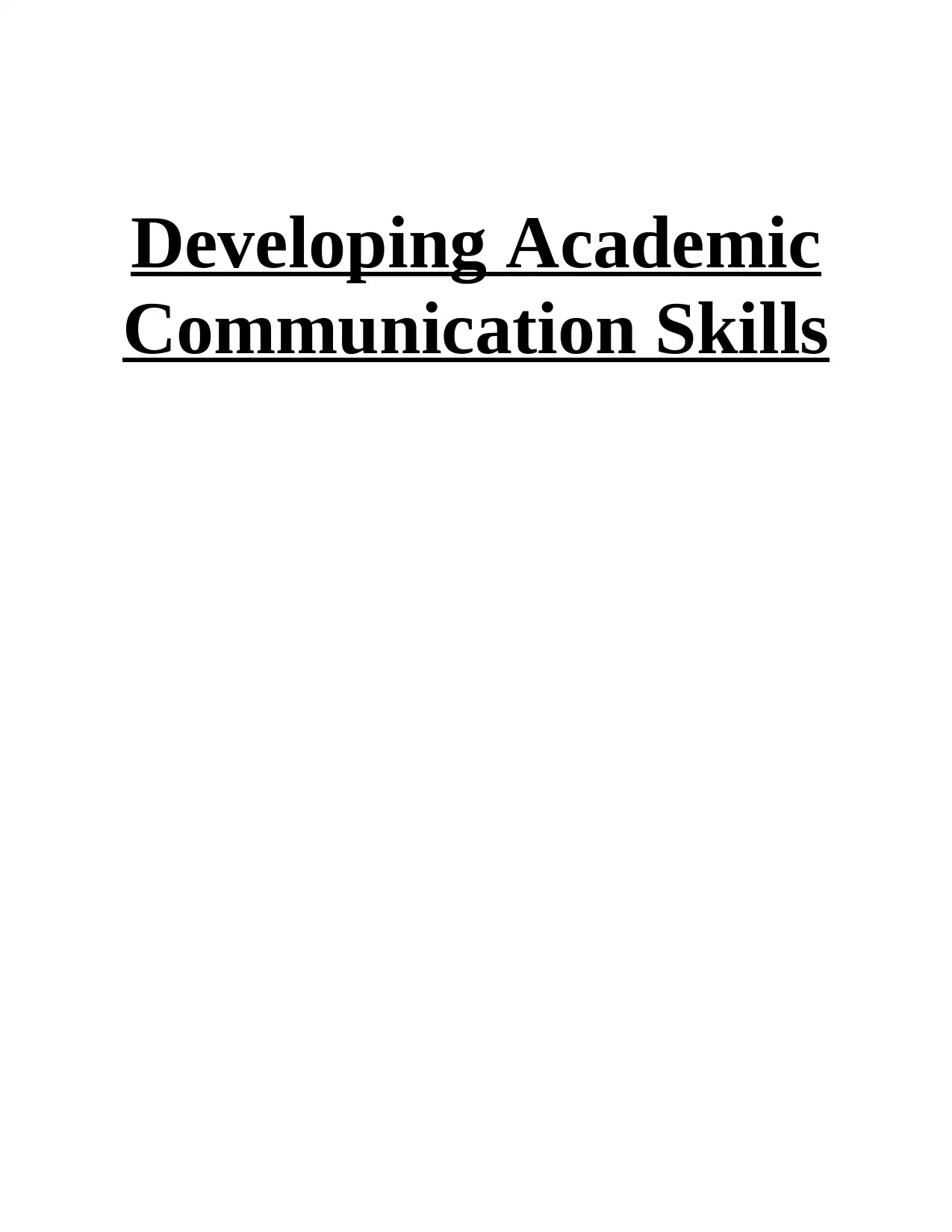
Developing Academic
Communication Skills
Communication Skills
Paraphrase This Document
Need a fresh take? Get an instant paraphrase of this document with our AI Paraphraser
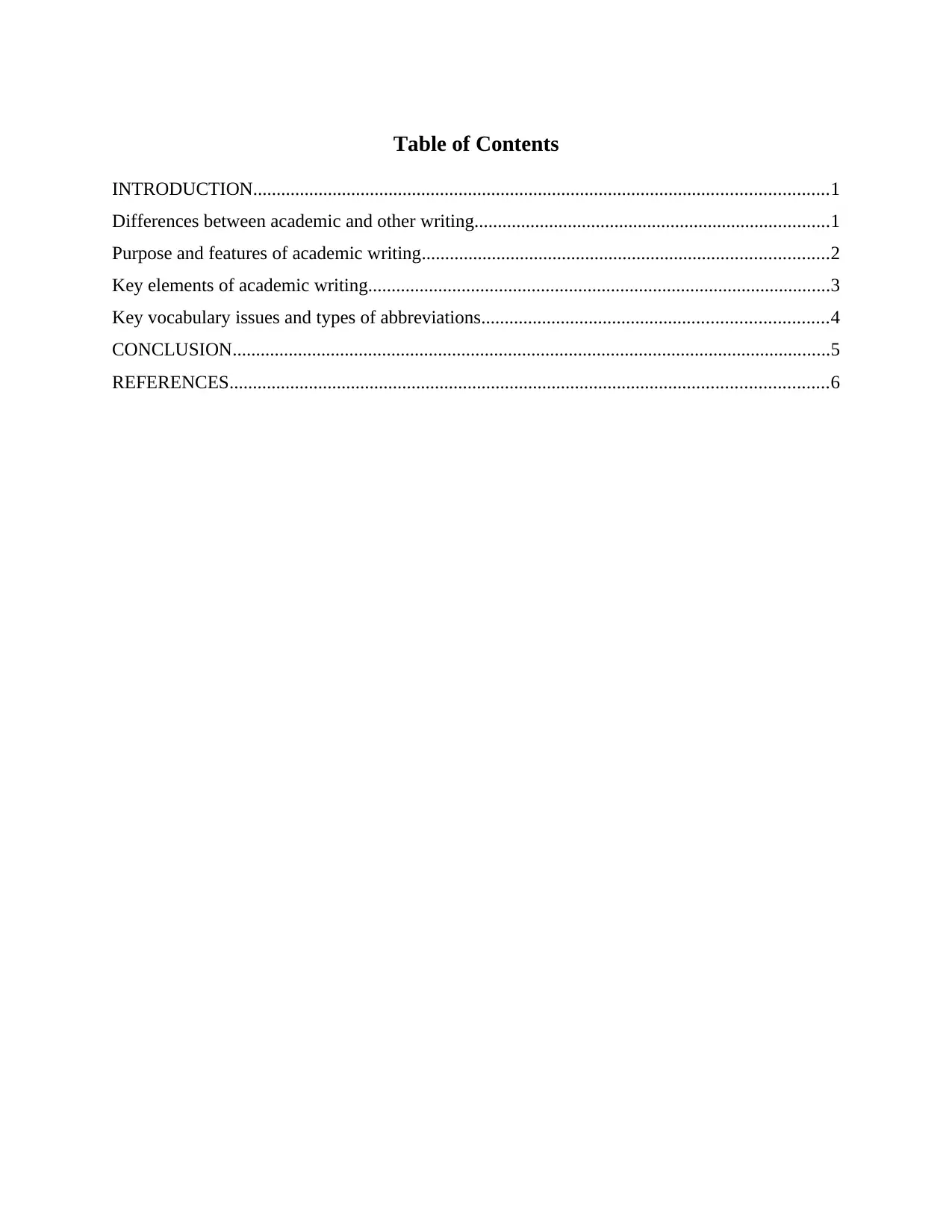
Table of Contents
INTRODUCTION...........................................................................................................................1
Differences between academic and other writing............................................................................1
Purpose and features of academic writing.......................................................................................2
Key elements of academic writing...................................................................................................3
Key vocabulary issues and types of abbreviations..........................................................................4
CONCLUSION................................................................................................................................5
REFERENCES................................................................................................................................6
INTRODUCTION...........................................................................................................................1
Differences between academic and other writing............................................................................1
Purpose and features of academic writing.......................................................................................2
Key elements of academic writing...................................................................................................3
Key vocabulary issues and types of abbreviations..........................................................................4
CONCLUSION................................................................................................................................5
REFERENCES................................................................................................................................6
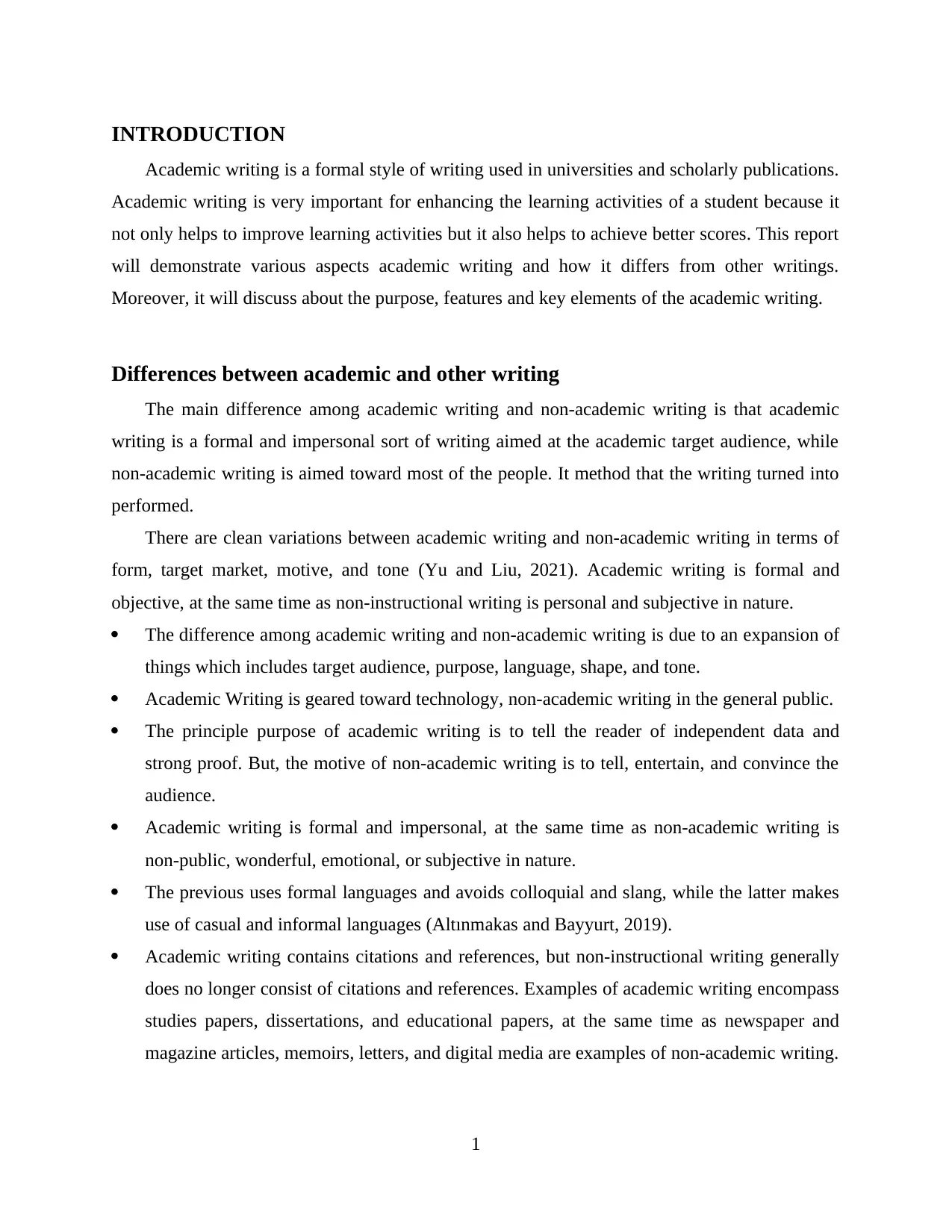
INTRODUCTION
Academic writing is a formal style of writing used in universities and scholarly publications.
Academic writing is very important for enhancing the learning activities of a student because it
not only helps to improve learning activities but it also helps to achieve better scores. This report
will demonstrate various aspects academic writing and how it differs from other writings.
Moreover, it will discuss about the purpose, features and key elements of the academic writing.
Differences between academic and other writing
The main difference among academic writing and non-academic writing is that academic
writing is a formal and impersonal sort of writing aimed at the academic target audience, while
non-academic writing is aimed toward most of the people. It method that the writing turned into
performed.
There are clean variations between academic writing and non-academic writing in terms of
form, target market, motive, and tone (Yu and Liu, 2021). Academic writing is formal and
objective, at the same time as non-instructional writing is personal and subjective in nature.
The difference among academic writing and non-academic writing is due to an expansion of
things which includes target audience, purpose, language, shape, and tone.
Academic Writing is geared toward technology, non-academic writing in the general public.
The principle purpose of academic writing is to tell the reader of independent data and
strong proof. But, the motive of non-academic writing is to tell, entertain, and convince the
audience.
Academic writing is formal and impersonal, at the same time as non-academic writing is
non-public, wonderful, emotional, or subjective in nature.
The previous uses formal languages and avoids colloquial and slang, while the latter makes
use of casual and informal languages (Altınmakas and Bayyurt, 2019).
Academic writing contains citations and references, but non-instructional writing generally
does no longer consist of citations and references. Examples of academic writing encompass
studies papers, dissertations, and educational papers, at the same time as newspaper and
magazine articles, memoirs, letters, and digital media are examples of non-academic writing.
1
Academic writing is a formal style of writing used in universities and scholarly publications.
Academic writing is very important for enhancing the learning activities of a student because it
not only helps to improve learning activities but it also helps to achieve better scores. This report
will demonstrate various aspects academic writing and how it differs from other writings.
Moreover, it will discuss about the purpose, features and key elements of the academic writing.
Differences between academic and other writing
The main difference among academic writing and non-academic writing is that academic
writing is a formal and impersonal sort of writing aimed at the academic target audience, while
non-academic writing is aimed toward most of the people. It method that the writing turned into
performed.
There are clean variations between academic writing and non-academic writing in terms of
form, target market, motive, and tone (Yu and Liu, 2021). Academic writing is formal and
objective, at the same time as non-instructional writing is personal and subjective in nature.
The difference among academic writing and non-academic writing is due to an expansion of
things which includes target audience, purpose, language, shape, and tone.
Academic Writing is geared toward technology, non-academic writing in the general public.
The principle purpose of academic writing is to tell the reader of independent data and
strong proof. But, the motive of non-academic writing is to tell, entertain, and convince the
audience.
Academic writing is formal and impersonal, at the same time as non-academic writing is
non-public, wonderful, emotional, or subjective in nature.
The previous uses formal languages and avoids colloquial and slang, while the latter makes
use of casual and informal languages (Altınmakas and Bayyurt, 2019).
Academic writing contains citations and references, but non-instructional writing generally
does no longer consist of citations and references. Examples of academic writing encompass
studies papers, dissertations, and educational papers, at the same time as newspaper and
magazine articles, memoirs, letters, and digital media are examples of non-academic writing.
1
⊘ This is a preview!⊘
Do you want full access?
Subscribe today to unlock all pages.

Trusted by 1+ million students worldwide
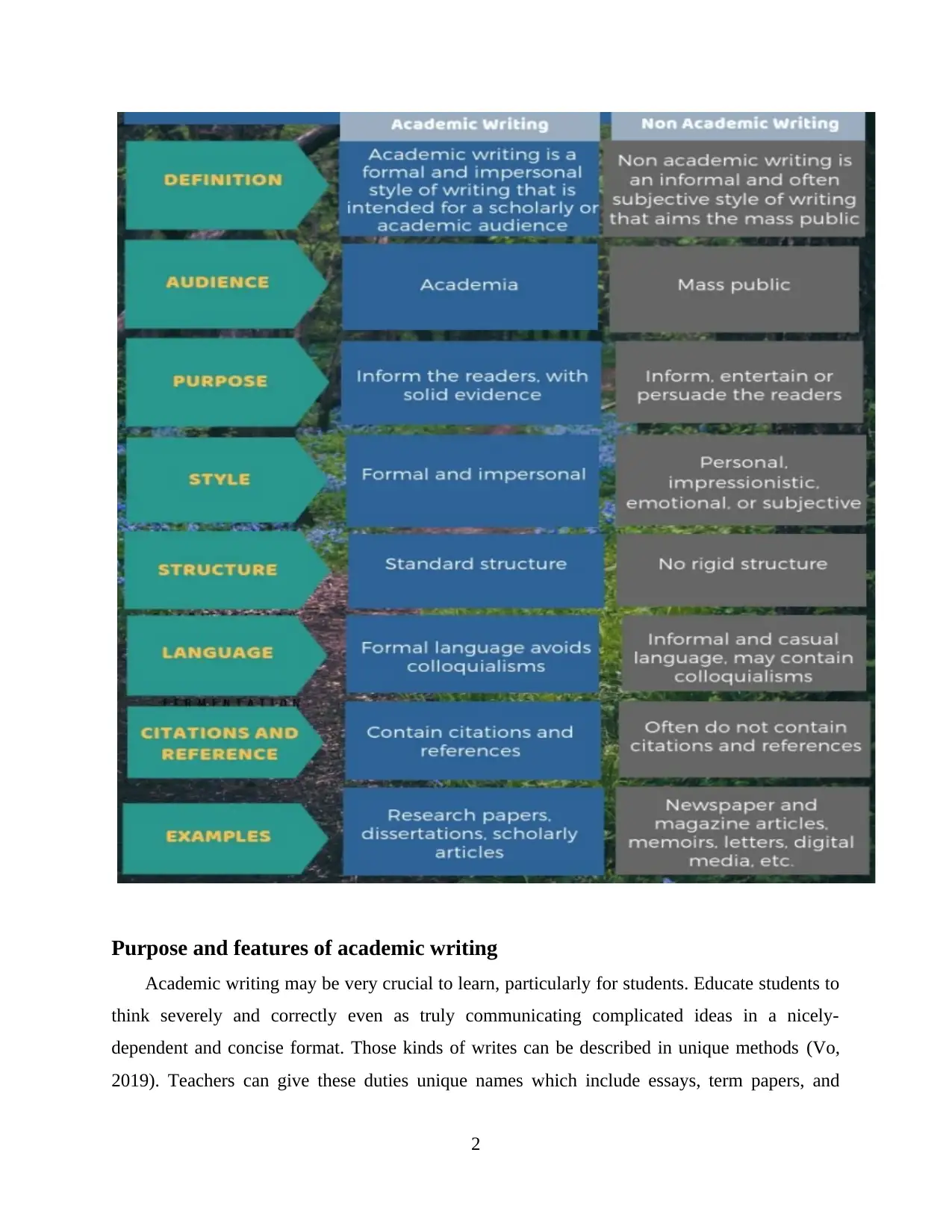
Purpose and features of academic writing
Academic writing may be very crucial to learn, particularly for students. Educate students to
think severely and correctly even as truly communicating complicated ideas in a nicely-
dependent and concise format. Those kinds of writes can be described in unique methods (Vo,
2019). Teachers can give these duties unique names which include essays, term papers, and
2
Academic writing may be very crucial to learn, particularly for students. Educate students to
think severely and correctly even as truly communicating complicated ideas in a nicely-
dependent and concise format. Those kinds of writes can be described in unique methods (Vo,
2019). Teachers can give these duties unique names which include essays, term papers, and
2
Paraphrase This Document
Need a fresh take? Get an instant paraphrase of this document with our AI Paraphraser
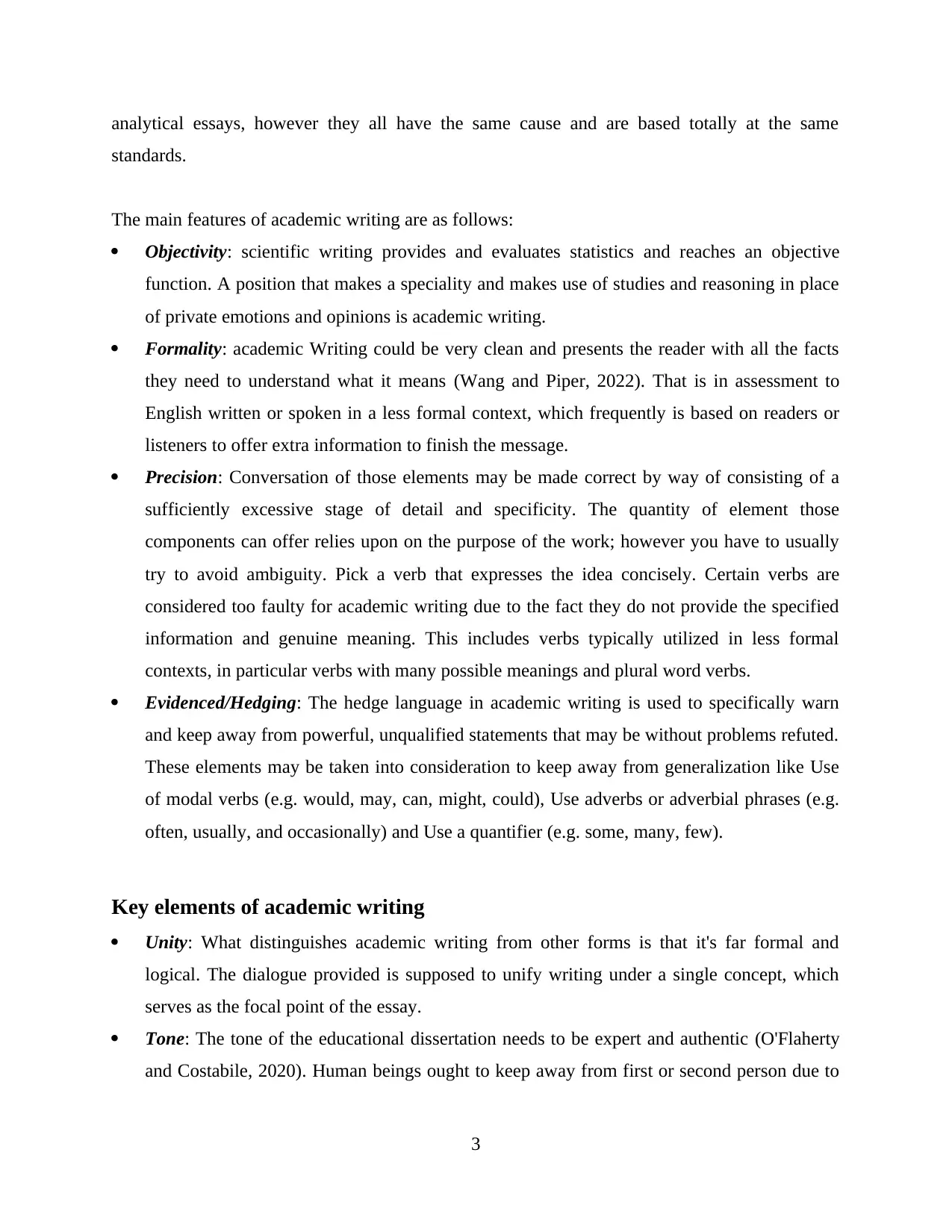
analytical essays, however they all have the same cause and are based totally at the same
standards.
The main features of academic writing are as follows:
Objectivity: scientific writing provides and evaluates statistics and reaches an objective
function. A position that makes a speciality and makes use of studies and reasoning in place
of private emotions and opinions is academic writing.
Formality: academic Writing could be very clean and presents the reader with all the facts
they need to understand what it means (Wang and Piper, 2022). That is in assessment to
English written or spoken in a less formal context, which frequently is based on readers or
listeners to offer extra information to finish the message.
Precision: Conversation of those elements may be made correct by way of consisting of a
sufficiently excessive stage of detail and specificity. The quantity of element those
components can offer relies upon on the purpose of the work; however you have to usually
try to avoid ambiguity. Pick a verb that expresses the idea concisely. Certain verbs are
considered too faulty for academic writing due to the fact they do not provide the specified
information and genuine meaning. This includes verbs typically utilized in less formal
contexts, in particular verbs with many possible meanings and plural word verbs.
Evidenced/Hedging: The hedge language in academic writing is used to specifically warn
and keep away from powerful, unqualified statements that may be without problems refuted.
These elements may be taken into consideration to keep away from generalization like Use
of modal verbs (e.g. would, may, can, might, could), Use adverbs or adverbial phrases (e.g.
often, usually, and occasionally) and Use a quantifier (e.g. some, many, few).
Key elements of academic writing
Unity: What distinguishes academic writing from other forms is that it's far formal and
logical. The dialogue provided is supposed to unify writing under a single concept, which
serves as the focal point of the essay.
Tone: The tone of the educational dissertation needs to be expert and authentic (O'Flaherty
and Costabile, 2020). Human beings ought to keep away from first or second person due to
3
standards.
The main features of academic writing are as follows:
Objectivity: scientific writing provides and evaluates statistics and reaches an objective
function. A position that makes a speciality and makes use of studies and reasoning in place
of private emotions and opinions is academic writing.
Formality: academic Writing could be very clean and presents the reader with all the facts
they need to understand what it means (Wang and Piper, 2022). That is in assessment to
English written or spoken in a less formal context, which frequently is based on readers or
listeners to offer extra information to finish the message.
Precision: Conversation of those elements may be made correct by way of consisting of a
sufficiently excessive stage of detail and specificity. The quantity of element those
components can offer relies upon on the purpose of the work; however you have to usually
try to avoid ambiguity. Pick a verb that expresses the idea concisely. Certain verbs are
considered too faulty for academic writing due to the fact they do not provide the specified
information and genuine meaning. This includes verbs typically utilized in less formal
contexts, in particular verbs with many possible meanings and plural word verbs.
Evidenced/Hedging: The hedge language in academic writing is used to specifically warn
and keep away from powerful, unqualified statements that may be without problems refuted.
These elements may be taken into consideration to keep away from generalization like Use
of modal verbs (e.g. would, may, can, might, could), Use adverbs or adverbial phrases (e.g.
often, usually, and occasionally) and Use a quantifier (e.g. some, many, few).
Key elements of academic writing
Unity: What distinguishes academic writing from other forms is that it's far formal and
logical. The dialogue provided is supposed to unify writing under a single concept, which
serves as the focal point of the essay.
Tone: The tone of the educational dissertation needs to be expert and authentic (O'Flaherty
and Costabile, 2020). Human beings ought to keep away from first or second person due to
3
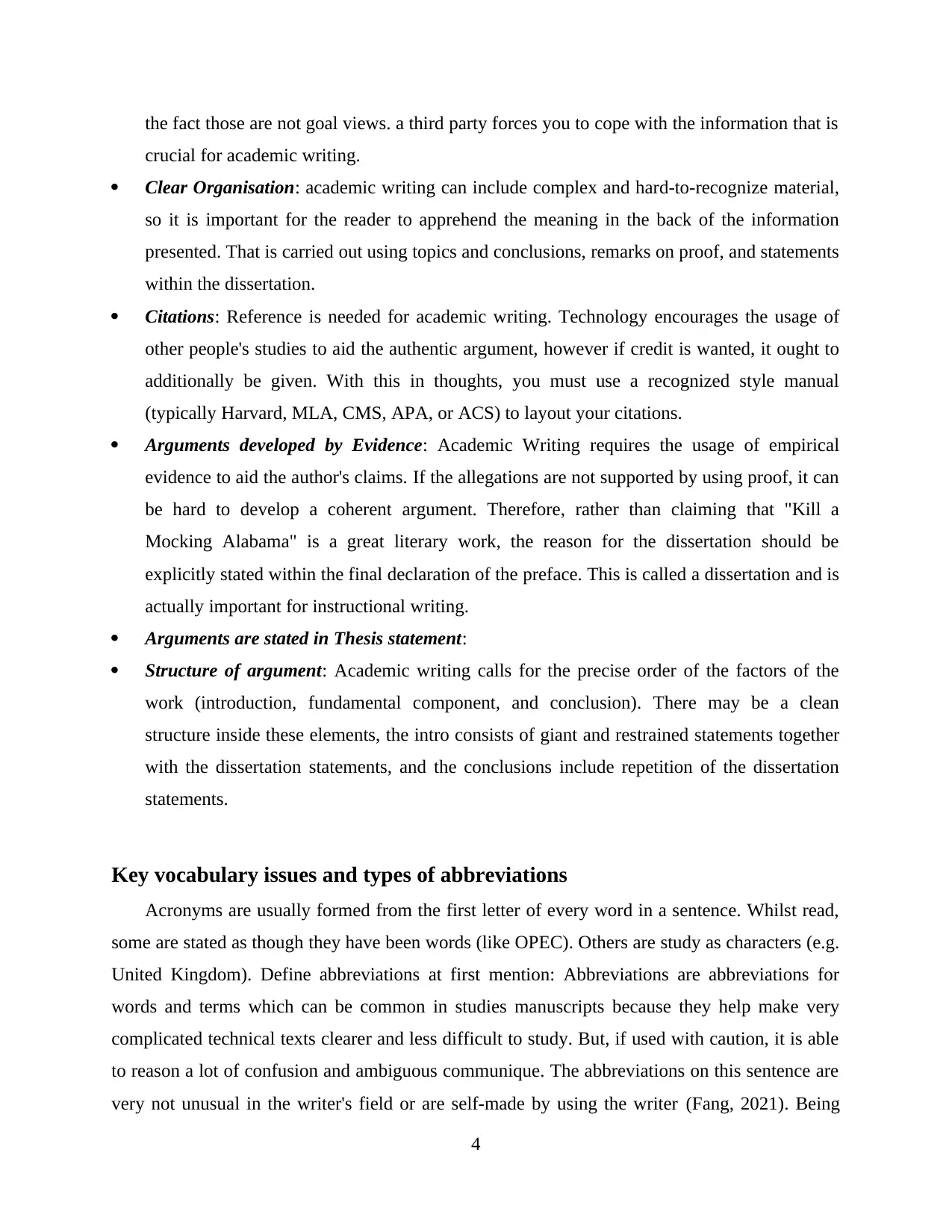
the fact those are not goal views. a third party forces you to cope with the information that is
crucial for academic writing.
Clear Organisation: academic writing can include complex and hard-to-recognize material,
so it is important for the reader to apprehend the meaning in the back of the information
presented. That is carried out using topics and conclusions, remarks on proof, and statements
within the dissertation.
Citations: Reference is needed for academic writing. Technology encourages the usage of
other people's studies to aid the authentic argument, however if credit is wanted, it ought to
additionally be given. With this in thoughts, you must use a recognized style manual
(typically Harvard, MLA, CMS, APA, or ACS) to layout your citations.
Arguments developed by Evidence: Academic Writing requires the usage of empirical
evidence to aid the author's claims. If the allegations are not supported by using proof, it can
be hard to develop a coherent argument. Therefore, rather than claiming that "Kill a
Mocking Alabama" is a great literary work, the reason for the dissertation should be
explicitly stated within the final declaration of the preface. This is called a dissertation and is
actually important for instructional writing.
Arguments are stated in Thesis statement:
Structure of argument: Academic writing calls for the precise order of the factors of the
work (introduction, fundamental component, and conclusion). There may be a clean
structure inside these elements, the intro consists of giant and restrained statements together
with the dissertation statements, and the conclusions include repetition of the dissertation
statements.
Key vocabulary issues and types of abbreviations
Acronyms are usually formed from the first letter of every word in a sentence. Whilst read,
some are stated as though they have been words (like OPEC). Others are study as characters (e.g.
United Kingdom). Define abbreviations at first mention: Abbreviations are abbreviations for
words and terms which can be common in studies manuscripts because they help make very
complicated technical texts clearer and less difficult to study. But, if used with caution, it is able
to reason a lot of confusion and ambiguous communique. The abbreviations on this sentence are
very not unusual in the writer's field or are self-made by using the writer (Fang, 2021). Being
4
crucial for academic writing.
Clear Organisation: academic writing can include complex and hard-to-recognize material,
so it is important for the reader to apprehend the meaning in the back of the information
presented. That is carried out using topics and conclusions, remarks on proof, and statements
within the dissertation.
Citations: Reference is needed for academic writing. Technology encourages the usage of
other people's studies to aid the authentic argument, however if credit is wanted, it ought to
additionally be given. With this in thoughts, you must use a recognized style manual
(typically Harvard, MLA, CMS, APA, or ACS) to layout your citations.
Arguments developed by Evidence: Academic Writing requires the usage of empirical
evidence to aid the author's claims. If the allegations are not supported by using proof, it can
be hard to develop a coherent argument. Therefore, rather than claiming that "Kill a
Mocking Alabama" is a great literary work, the reason for the dissertation should be
explicitly stated within the final declaration of the preface. This is called a dissertation and is
actually important for instructional writing.
Arguments are stated in Thesis statement:
Structure of argument: Academic writing calls for the precise order of the factors of the
work (introduction, fundamental component, and conclusion). There may be a clean
structure inside these elements, the intro consists of giant and restrained statements together
with the dissertation statements, and the conclusions include repetition of the dissertation
statements.
Key vocabulary issues and types of abbreviations
Acronyms are usually formed from the first letter of every word in a sentence. Whilst read,
some are stated as though they have been words (like OPEC). Others are study as characters (e.g.
United Kingdom). Define abbreviations at first mention: Abbreviations are abbreviations for
words and terms which can be common in studies manuscripts because they help make very
complicated technical texts clearer and less difficult to study. But, if used with caution, it is able
to reason a lot of confusion and ambiguous communique. The abbreviations on this sentence are
very not unusual in the writer's field or are self-made by using the writer (Fang, 2021). Being
4
⊘ This is a preview!⊘
Do you want full access?
Subscribe today to unlock all pages.

Trusted by 1+ million students worldwide
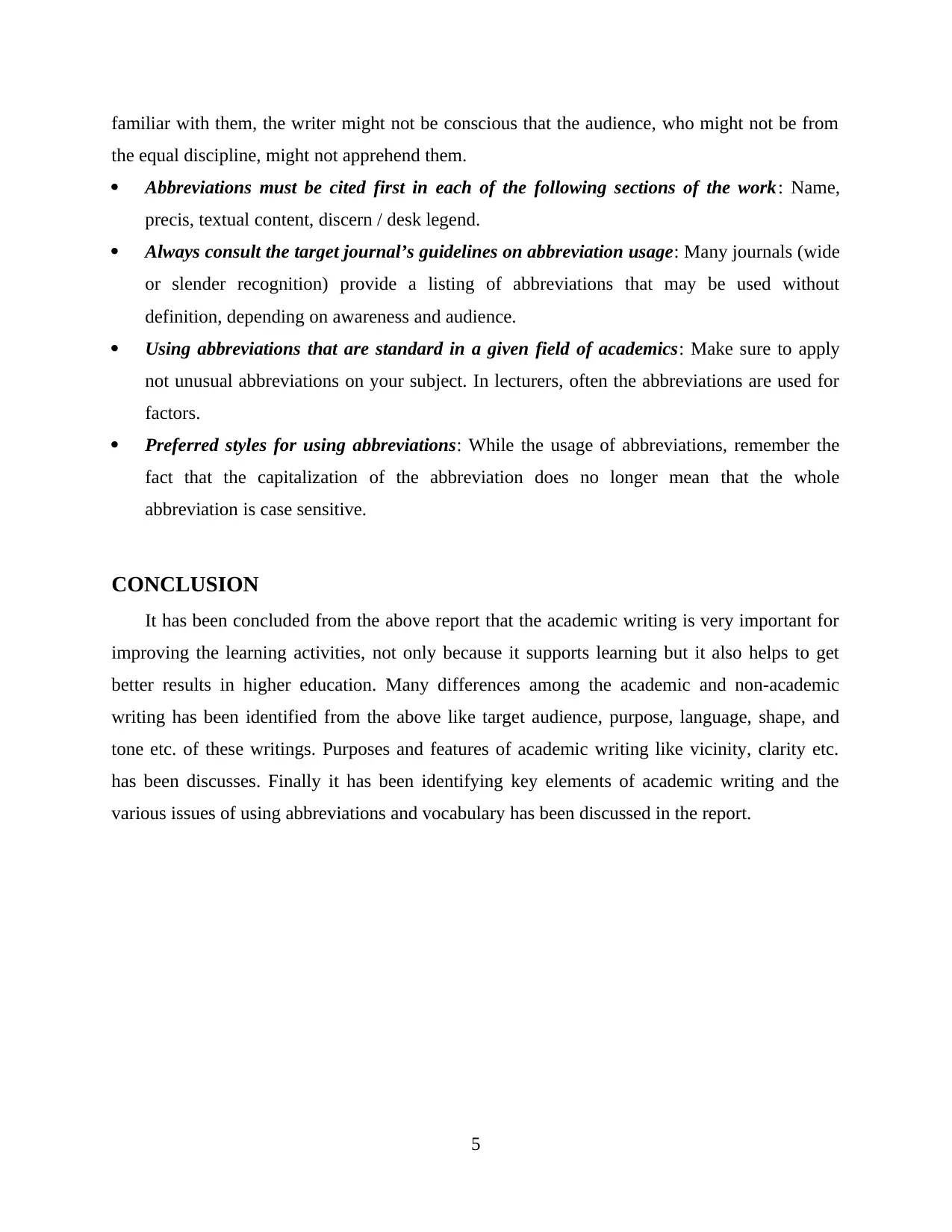
familiar with them, the writer might not be conscious that the audience, who might not be from
the equal discipline, might not apprehend them.
Abbreviations must be cited first in each of the following sections of the work: Name,
precis, textual content, discern / desk legend.
Always consult the target journal’s guidelines on abbreviation usage: Many journals (wide
or slender recognition) provide a listing of abbreviations that may be used without
definition, depending on awareness and audience.
Using abbreviations that are standard in a given field of academics: Make sure to apply
not unusual abbreviations on your subject. In lecturers, often the abbreviations are used for
factors.
Preferred styles for using abbreviations: While the usage of abbreviations, remember the
fact that the capitalization of the abbreviation does no longer mean that the whole
abbreviation is case sensitive.
CONCLUSION
It has been concluded from the above report that the academic writing is very important for
improving the learning activities, not only because it supports learning but it also helps to get
better results in higher education. Many differences among the academic and non-academic
writing has been identified from the above like target audience, purpose, language, shape, and
tone etc. of these writings. Purposes and features of academic writing like vicinity, clarity etc.
has been discusses. Finally it has been identifying key elements of academic writing and the
various issues of using abbreviations and vocabulary has been discussed in the report.
5
the equal discipline, might not apprehend them.
Abbreviations must be cited first in each of the following sections of the work: Name,
precis, textual content, discern / desk legend.
Always consult the target journal’s guidelines on abbreviation usage: Many journals (wide
or slender recognition) provide a listing of abbreviations that may be used without
definition, depending on awareness and audience.
Using abbreviations that are standard in a given field of academics: Make sure to apply
not unusual abbreviations on your subject. In lecturers, often the abbreviations are used for
factors.
Preferred styles for using abbreviations: While the usage of abbreviations, remember the
fact that the capitalization of the abbreviation does no longer mean that the whole
abbreviation is case sensitive.
CONCLUSION
It has been concluded from the above report that the academic writing is very important for
improving the learning activities, not only because it supports learning but it also helps to get
better results in higher education. Many differences among the academic and non-academic
writing has been identified from the above like target audience, purpose, language, shape, and
tone etc. of these writings. Purposes and features of academic writing like vicinity, clarity etc.
has been discusses. Finally it has been identifying key elements of academic writing and the
various issues of using abbreviations and vocabulary has been discussed in the report.
5
Paraphrase This Document
Need a fresh take? Get an instant paraphrase of this document with our AI Paraphraser
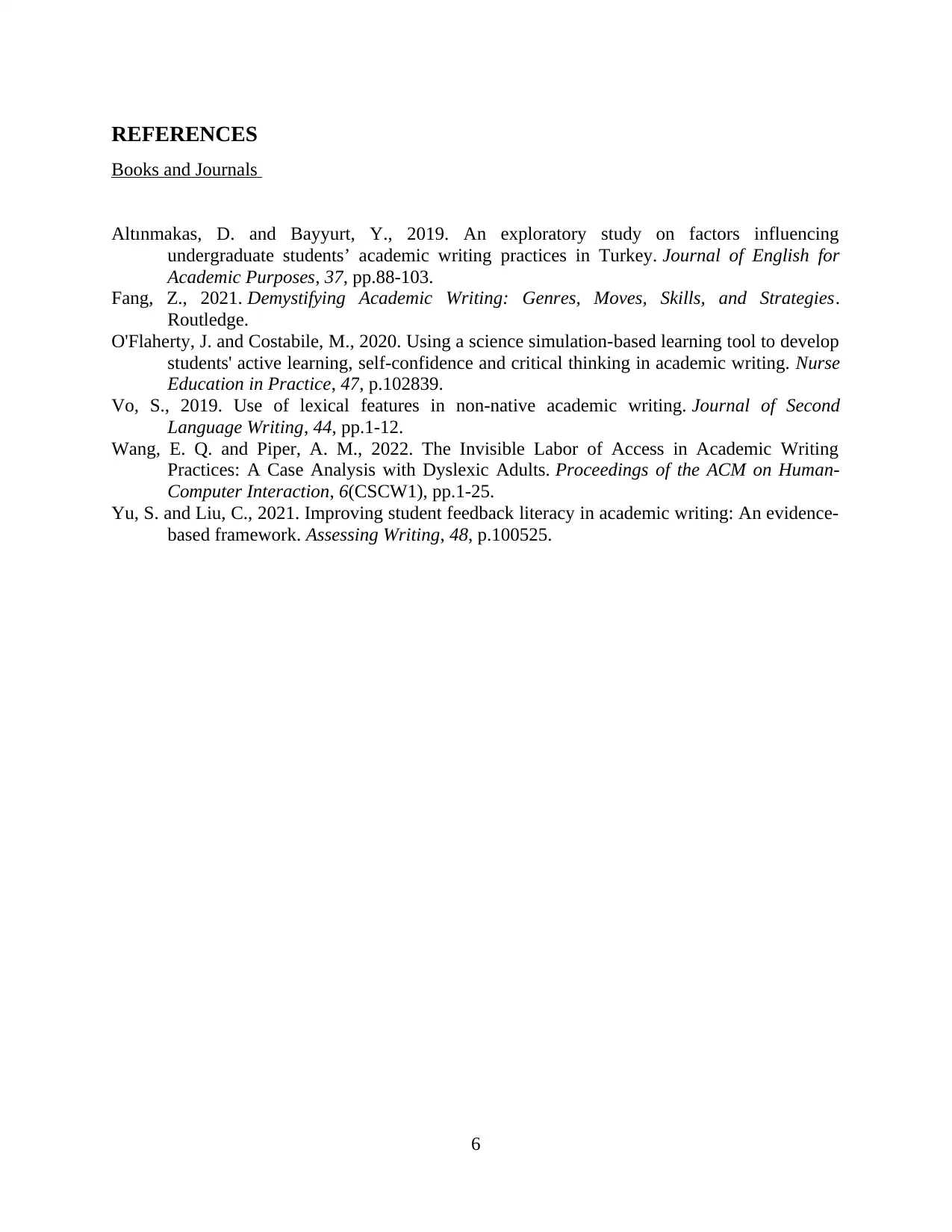
REFERENCES
Books and Journals
Altınmakas, D. and Bayyurt, Y., 2019. An exploratory study on factors influencing
undergraduate students’ academic writing practices in Turkey. Journal of English for
Academic Purposes, 37, pp.88-103.
Fang, Z., 2021. Demystifying Academic Writing: Genres, Moves, Skills, and Strategies.
Routledge.
O'Flaherty, J. and Costabile, M., 2020. Using a science simulation-based learning tool to develop
students' active learning, self-confidence and critical thinking in academic writing. Nurse
Education in Practice, 47, p.102839.
Vo, S., 2019. Use of lexical features in non-native academic writing. Journal of Second
Language Writing, 44, pp.1-12.
Wang, E. Q. and Piper, A. M., 2022. The Invisible Labor of Access in Academic Writing
Practices: A Case Analysis with Dyslexic Adults. Proceedings of the ACM on Human-
Computer Interaction, 6(CSCW1), pp.1-25.
Yu, S. and Liu, C., 2021. Improving student feedback literacy in academic writing: An evidence-
based framework. Assessing Writing, 48, p.100525.
6
Books and Journals
Altınmakas, D. and Bayyurt, Y., 2019. An exploratory study on factors influencing
undergraduate students’ academic writing practices in Turkey. Journal of English for
Academic Purposes, 37, pp.88-103.
Fang, Z., 2021. Demystifying Academic Writing: Genres, Moves, Skills, and Strategies.
Routledge.
O'Flaherty, J. and Costabile, M., 2020. Using a science simulation-based learning tool to develop
students' active learning, self-confidence and critical thinking in academic writing. Nurse
Education in Practice, 47, p.102839.
Vo, S., 2019. Use of lexical features in non-native academic writing. Journal of Second
Language Writing, 44, pp.1-12.
Wang, E. Q. and Piper, A. M., 2022. The Invisible Labor of Access in Academic Writing
Practices: A Case Analysis with Dyslexic Adults. Proceedings of the ACM on Human-
Computer Interaction, 6(CSCW1), pp.1-25.
Yu, S. and Liu, C., 2021. Improving student feedback literacy in academic writing: An evidence-
based framework. Assessing Writing, 48, p.100525.
6
1 out of 8
Related Documents
Your All-in-One AI-Powered Toolkit for Academic Success.
+13062052269
info@desklib.com
Available 24*7 on WhatsApp / Email
![[object Object]](/_next/static/media/star-bottom.7253800d.svg)
Unlock your academic potential
Copyright © 2020–2025 A2Z Services. All Rights Reserved. Developed and managed by ZUCOL.


